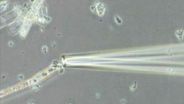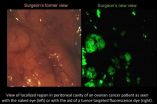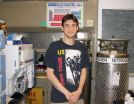(Press-News.org) The crystal structure of the dynamin protein — one of the molecular machines that makes cells work — has been revealed, bringing insights into a class of molecules with a wide influence on health and disease.
"It's a really cool structure," said Jodi Nunnari, professor and chair of molecular and cellular biology at UC Davis and senior author of the paper, to be published Sept. 18 in the journal Nature. "This is a really important class of molecules for regulating membrane dynamics."
The detailed structure reveals exactly how the dynamin protein can form large assemblies that pinch off bubbles, or vesicles, from cell membranes. These vesicles allow a cell to "eat" proteins, liquids or other items from the outside, compartmentalize them and move them around within itself.
Marijn Ford, a postdoctoral scholar in Nunnari's laboratory, mapped the crystal structure of dynamin-1 in collaboration with Simon Jenni, a research fellow at Harvard University.
Dynamin belongs to a large family of proteins that, in the right conditions, can self-assemble into larger structures and generate force. Those properties of self-assembly and movement can be harnessed in the cell for different functions.
Dynamin-1 itself is involved in making vesicles in nerve cells at the points where nerves form connections, or synapses, with each other. Nerve cells communicate through chemical messengers (neurotransmitters) that are released from and taken up by vesicles. Altering the balance of these messengers can affect mental function. For example, an important class of antidepressant drugs works by affecting the uptake of the neurotransmitter serotonin.
The new crystal structure shows exactly how the individual dynamin proteins can line up to form a helix, and then move by ratcheting alongside each other.
It also shows that part of the protein can interact with lipids in cell membranes. That could allow different types of dynamin protein to interact with subtly different types of membrane, specializing their function.
Understanding these miniature motors also might make it possible one day to engineer cells that can do new and different tasks, Nunnari said.
###
The work was funded by grants from the National Institutes of Health and the Howard Hughes Medical Institute.
Crystal structure shows how motor protein works
2011-09-19
ELSE PRESS RELEASES FROM THIS DATE:
Osteoporosis Phase III data at 2011 ASBMR Show oral calcitonin tablet is safe and effective
2011-09-19
SAN DIEGO, CA and PHILADELPHIA, PA – September 18, 2011 —Tarsa Therapeutics today presented positive safety and efficacy data from its Phase III ORACAL trial of OSTORA™, the company's oral recombinant salmon calcitonin tablet in development for the treatment of postmenopausal osteoporosis. These data were presented at the American Society for Bone and Mineral Research 2011 Annual Meeting by ORACAL investigator Neil Binkley, MD, who is an Associate Professor of Endocrinology and Geriatrics at the University of Wisconsin School of Medicine and Public Health in Madison, ...
Why carbon nanotubes spell trouble for cells
2011-09-19
VIDEO:
Receptors on the cell's surface crowd around the nanotube, effectively standing it upright. The cell mistakes the tube for a sphere and begins to engulf it.
Click here for more information.
PROVIDENCE, R.I. [Brown University] — It's been long known that asbestos spells trouble for human cells. Scientists have seen cells stabbed with spiky, long asbestos fibers, and the image is gory: Part of the fiber is protruding from the cell, like a quivering arrow that's found ...
Researchers sequence dark matter of life
2011-09-19
Researchers have developed a new method to sequence and analyze the dark matter of life—the genomes of thousands of bacteria species previously beyond scientists' reach, from microorganisms that produce antibiotics and biofuels to microbes living in the human body.
Scientists from UC San Diego, the J. Craig Venter Institute and Illumina Inc., published their findings in the Sept. 18 online issue of the journal Nature Biotechnology. The breakthrough will enable researchers to assemble virtually complete genomes from DNA extracted from a single bacterial cell. By contrast, ...
Deep oceans can mask global warming for decade-long periods
2011-09-19
BOULDER -- The planet's deep oceans at times may absorb enough heat to flatten the rate of global warming for periods of as long as a decade even in the midst of longer-term warming, according to a new analysis led by the National Center for Atmospheric Research (NCAR).
The study, based on computer simulations of global climate, points to ocean layers deeper than 1,000 feet (300 meters) as the main location of the "missing heat" during periods such as the past decade when global air temperatures showed little trend. The findings also suggest that several more intervals ...
Purdue technology used in first fluorescence-guided ovarian cancer surgery
2011-09-19
WEST LAFAYETTE, Ind. - The first fluorescence-guided surgery on an ovarian cancer patient was performed using a cancer cell "homing device" and imaging agent created by a Purdue University researcher.
The surgery was one of 10 performed as part of the first phase of a clinical trial to evaluate a new technology to aid surgeons in the removal of malignant tissue from ovarian cancer patients. The method illuminates cancer cells to help surgeons identify and remove smaller tumors that could otherwise be missed.
Philip Low, the Ralph C. Corely Distinguished Professor of ...
Nanoparticles cause brain injury in fish
2011-09-19
Scientists at the University of Plymouth have shown, for the first time in an animal, that nanoparticles have a detrimental effect on the brain and other parts of the central nervous system.
They subjected rainbow trout to titanium oxide nanoparticles which are widely used as a whitening agent in many products including paints, some personal care products, and with applications being considered for the food industry. They found that the particles caused vacuoles (holes) to form in parts of the brain and for nerve cells in the brain to die. Although some effects of nanoparticles ...
Milking the pigeon: extracting the mechanisms involved
2011-09-19
Production of crop milk, a secretion from the crops of parent birds, is rare among birds and, apart from pigeons, is only found in flamingos and male emperor penguins. Essential for the growth and development of the young pigeon squab, pigeon 'milk' is produced by both parents from fluid-filled cells lining the crop that are rich in fat and protein. Research published in BioMed Central's open access journal BMC Genomics uses new technology to study the genes and proteins involved in pigeon 'milk' production and shows that pigeon 'milk' contains antioxidants and immune-enhancing ...
Reassurance for dementia sufferers on impact of common drugs
2011-09-19
Researchers whose findings on the detrimental impact of some common medicines on elderly people were widely reported earlier in the summer have found that taking a few of these medicines does not appear to cause further cognitive impairment in those already suffering from dementia.
In a paper published today by the journal Age and Ageing, Dr Chris Fox of the University of East Anglia (UEA) and colleagues from a number of other universities and the NHS describe how they studied a clinically representative sample of 224 people with established Alzheimer's dementia who ...
For unzipping DNA mysteries -- literally -- Cornell physicists discover how a vital enzyme works
2011-09-19
ITHACA, N.Y. – With an eye toward understanding DNA replication, Cornell researchers have learned how a helicase enzyme works to actually unzip the two strands of DNA. (Nature, online Sept. 18, 2011.)
At the heart of many metabolic processes, including DNA replication, are enzymes called helicases. Acting like motors, these proteins travel along one side of double-stranded DNA, prompting the strands to "zip" apart.
What had been a mystery was the exact mechanics of this vital biological process – how individual helicase subunits coordinate and physically cause the unzipping ...
Gamers succeed where scientists fail
2011-09-19
Gamers have solved the structure of a retrovirus enzyme whose configuration had stumped scientists for more than a decade. The gamers achieved their discovery by playing Foldit, an online game that allows players to collaborate and compete in predicting the structure of protein molecules.
After scientists repeatedly failed to piece together the structure of a protein-cutting enzyme from an AIDS-like virus, they called in the Foldit players. The scientists challenged the gamers to produce an accurate model of the enzyme. They did it in only three weeks.
This class ...




